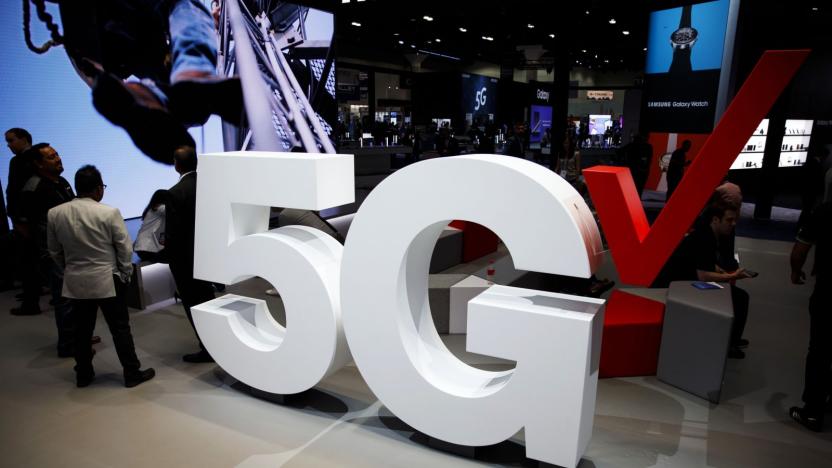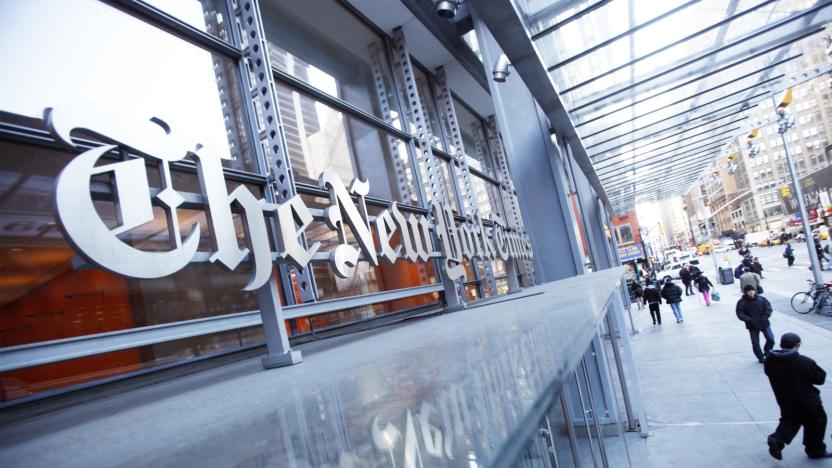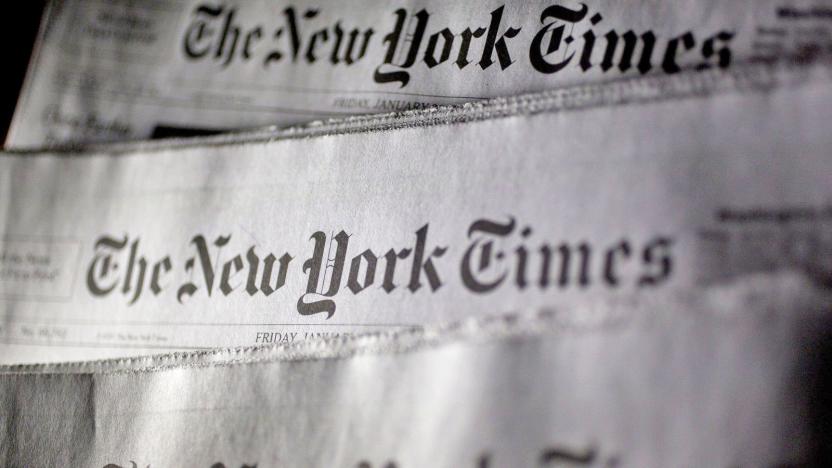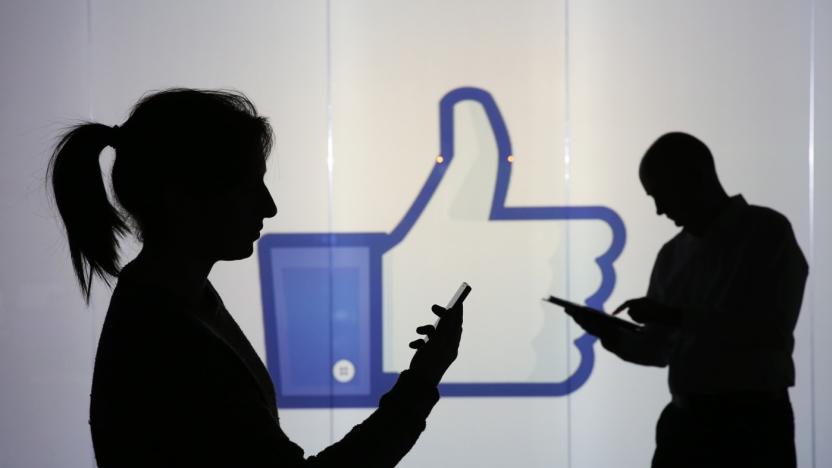thenewyorktimes
Latest

Verizon and Disney think 5G can 'transform' entertainment
Verizon has announced at CES 2019 that it's teaming up with Walt Disney Studios to bring emerging technologies, namely 5G, to media and entertainment. The partnership is designed to deliver the network's 5G connectivity to every facet of the studio's work, from production to personal consumer experiences. According to Variety, the deal between the two companies will give Disney's StudioLab the ability to tap into Verizon's next-gen wireless broadband, which offers data transferring speeds of up to 10 gigabits per second.

Does social media threaten the illusion of news neutrality?
For journalists, social media can be a double-edged sword. On the one hand, they can use platforms like Facebook and Twitter to share their opinion on a wide range of matters, from sports to politics. But at the same time, they have to remember to exercise caution, because whatever they say can be taken out of context and have major implications on the publications they work for. If a reader who follows your tweets or Facebook posts doesn't agree with you, that can motivate them to claim your entire newsroom is biased.

New York Times reporters' tweets will appear in its paper edition
The pages just inside the print edition of The New York Times had previously been used to list corrections and article summaries for later stories. Last week, the newspaper announced a shakeup that redesigned A2 and A3 into landing pages featuring noteworthy facts from the day's stories, historical headlines from the paper's past and behind-the-scenes looks at its journalistic endeavors. But the new front section will also include a first for the Gray Lady: Featuring its reporters' tweets in newsprint.

Six places where renewable energy is cheaper than fossil fuels
By Cat DiStasio In the race to reduce the world's reliance on fossil fuels, cost is a huge factor. It's taken years, but advances in technology and increases in both efficiency and output have helped bring down the expense of renewable energy, which has in turn increased demand. Globally, fossil fuels are still cheaper than these alternative sources, but there are a few places around the world where clean energy is winning, dollar for dollar. Sometimes, too, there's so much of it that the market price drops to zero. With the cost of renewable energy getting lower by the year, if not the month, environmental advocates are hopeful that energy sources like solar and wind power can eventually edge out fossil fuels entirely. Let's take a look at some of the locales where renewable energy is proving that a clean world doesn't have to be more expensive.

Facebook should know by now what's news and what's spam
Late last week, The Guardian published an interview with a survivor of Obama's first drone strike, which occurred in tribal Pakistan on his third day as president. It detailed the impact the attack had and raised concerns over the civilian damage these drone strikes can cause. But as important as this story sounds, you would not have been able to share it on Facebook. If you tried to do so, Facebook would have blocked you.

Starbucks app to serve up free New York Times articles
It's clear that Starbucks aims to pull in media companies for its Rewards program: after teaming up with Spotify earlier this year, the coffeehouse chain is now partnering with The New York Times. You can already get access to 15 free articles from NYT on Starbucks' app, but this deal expands their partnership further. Starting in 2016, you'll get access to the top news of the day, daily/weekend briefings and even more timely articles "addressing key social, political and economic issues" for free.

New York Times to refine subscription model in wake of sliding ad revenue
If you're an avid reader of The New York Times, you're probably already familiar with its complex subscription model that ranges in price between $15 and $35 per month. Yes, it's sometimes costly to stay in the loop, but on the upside of the paywall, company CEO Mark Thompson says that readers will soon find a wider array of content packages, including less expensive options. The move may be necessary, and according to Bloomberg, the CEO painted it as "the single most important thing we're doing in the company." Today, The New York Times released its earnings for the quarter, which came in slightly below expectations and revealed a decrease in advertising revenue. Recognizing the shift, Thompson will work to make the organization less reliant on ad revenue and more focused on digital subscriptions. As for its growth strategy, it's said that we can expect lower pricing tiers that offer access to specific content such as politics, technology and the arts, along with premium tiers that provide feature content and access to events. Curiously, videos and even games will be in the mix, but it's currently unclear where that'll fit into the tiered strategy. The New York Times currently serves 708,000 subscribers, which represents a 45 percent increase from the first quarter of 2012. It's said that we can expect the refined subscription model to arrive sometime in late 2013 or early 2014, and it'll be very interesting to see just how complex the outlet can go with its pricing. [Image credit: Adam Kinney / Flickr]

New York Times videos now exempt from paywall, free 'for the foreseeable future'
The New York Times announced this morning that its paywall is coming down from the videos section of its website, meaning that you can now enjoy more than 10 videos per month about vegetable caramelization best practices. The free access comes at the price of advertiser content, of course, which runs ahead of the videos and hocks both Microsoft wares and Acura vehicles currently. A NYT press rep told Engadget that the move to unlimited video access isn't temporary, but "never say never." We were also told that it isn't a test, and, "This is what we're doing now. In terms of when and if we'll move it back behind the gateway, we'll cross that bridge when we come to it. We literally have no idea. For the foreseeable future, it's free." The Grey Lady has been experimenting with its digital presence for several years now, and the publication instituted a site-wide paywall in 2011. The setup allowed readers free access to 10 pieces per month before being forced to login with a paid access account -- like so many paywalls, it can be easily gotten around using alternate web browsers, and, for a long while, by simply removing a chunk of the URL that redirected visitors to its paywall, anyone could read an unlimited amount of stories / watch unlimited videos. The paper's seen financial success in digital form as of late, reporting increased subscriber numbers and increased digital revenue alongside ever-decreasing ad sales.

Tesla vs. The Times: What one review means for the future of auto news
It's been hard to miss, this brouhaha that's been boiling over between Tesla CEO Elon Musk and The New York Times -- specifically with reporter John M. Broder. Broder published a piece over the weekend called "Stalled Out on Tesla's Electric Highway" in which he panned the Model S for inaccurate range estimates and drastically reduced range in cold weather. In fact, about the only thing he didn't hate was the tow truck driver who was ultimately dispatched to pick up him and the charge-depleted Tesla he had been driving through Connecticut. Musk, likely still stinging from an even more vitriolic 2011 takedown by Top Gear, was quick to take to Twitter and call the article "fake." He later backed that up with comprehensive data logs recorded, apparently, without Broder's knowledge. That data, at least at surface value, shows the Times piece is at best misleading -- at worst libelous. Case closed? Oh no, this is just beginning. In posting this data, and in chastising Broder's driving habits, Musk inadvertently refocused the situation onto himself. Instead of asking how the Times allowed this piece to be published, many are instead asking whether it's right for Tesla to be placing any sort of expectations on reviewers. And then, of course, there's the disconcerting Big Brother aspect of the whole case. Who's in the right? Who's in the wrong? Let's try to find out.

Tesla CEO Elon Musk calls NY Times article criticizing Model S a 'fake'
We recently had a chance to put a Tesla Model S through its paces and we had no problem getting where we were going -- and back again -- despite our testing happening in Upstate New York in the middle of a rather chilly January. The New York Times, however, had a bit of a harder time of it. Over the weekend, Times reporter John M. Broder published what can only be called a negative report on a failed trip to one of Tesla's fabled Superchargers. After a series of short charges and a series of drives in a Model S (the very same car we tested, we would add), Broder ultimately ran out of juice and was left stranded, having to tow the car from Branford, CT to the nearest Supercharger, this one in Milford -- about 25 miles away. Broder blamed the temperature and, ultimately, the car for causing the disappointment -- something Tesla CEO Elon Musk took to Twitter to rebut, saying: NYTimes article about Tesla range in cold is fake. Vehicle logs tell true story that he didn't actually charge to max & took a long detour. The Times responded (via CNBC) that the report was "completely factual" and that "Any suggestion that the account was 'fake' is, of course, flatly untrue." Musk then took to CNBC himself to talk about a "lengthy detour" Broder took through Manhattan -- something not mentioned in his post. In our own experiences, we definitely did notice a decreased indicated range immediately after turning on the car, but it quickly rose as they gradually rose to operating temperature. That said, we were never able to eke out the "indicated" range in the cold on either of our lengthy trips -- even those that didn't involve trips through Manhattan.

NYT: Steam's Big Picture public beta begins Monday
Can't wait to use Steam's forthcoming Big Picture mode to game from the comfort of your couch? Well, you're in luck, because it might be ready for a test drive tomorrow. According to The New York Times, the living room-friendly user interface is getting the public beta treatment starting Monday. Gabe Newell let loose last month that both the TV-geared view and Steam for Linux betas would be "out there fairly quickly," but there's still no word on when the Ubuntu-bound preview will land. In the meantime, we'll keep busy by gawking at Valve's augmented reality headset, which the NYT got a glimpse of during a trip to the firm's headquarters, at the source link below.

FTC considering new settlement process so companies can't deny wrongdoing
Google recently paid the FTC $22.5 million and Facebook was ordered by the commission to change the way it handles data, but you might be surprised to hear that both companies did nothing wrong. Well, not exactly, but by settling their privacy violation cases, the internet giants are entitled to deny any misconduct. The New York Times reports that J. Thomas Rosch, a commissioner who voted against both settlements, feels that current rules will invite "denials of liability in every case in the future." Rosch wants the policy changed so companies can't deny responsibility when settling, much like the way the SEC handles similar indiscretions. Most of his colleagues weren't in a hurry to back his opinions, but three did say that refining the process could "avoid any possible public misimpression" of how the FTC strikes such deals. The commission is expected to look at the issue in the near future, but until then, we're sure you're more than able to separate the reality from the legalese.

New York Times nears half-million online subscriber mark, halves free article allowance to celebrate
The New York Times just gave you more reason to consider making the jump to a paid online subscription -- beginning in April, that free article allowance will see a 50-percent cut, from 20 monthly articles to just 10. This modification comes one year after NYTimes.com launched its infamous content paywall, and following an announcement that the publisher has signed up 454,000 digital subscribers. Paying readers will receive a 12-week subscription that they can gift to anyone on the fence about swiping for access, and smartphone and tablet app users will continue to have access to the "Top News" sections for free. You'll also be able to read articles linked from other sites on the web, including your inbox, and can access five free posts a day that appear in search engine results. Completely unfettered access will range in price from $15 to $35 per month -- you'll find full details in the PR just past the break, and at the source link below.

Barnes & Noble offers discounted Nooks with one-year subscription to The New York Times
In the market for an e-reader and a subscription to the digital edition of The New York Times? Then Barnes & Noble has a new promotion you might want to consider. From now through March 9th, it'll give you a Nook Simple Touch for free or a Nook Color for $99 if you also sign up for a one-year New York Times subscription at a rate of $19.99/month. That's a savings of $100 in both cases, and the subscription also includes access to the New York Times website in addition to the Nook version. Alternatively, you can get $50 off the Nook Tablet (bringing it down to $199) with a subscription to People, which will run you $9.99/month. Complete details are at the link below.

New York Times' magic mirror helps you get dressed, puts the 'wall' in 'paywall' (video)
Forget crosswords and Krugman, because the New York Times has created a new bathroom companion that looks infinitely more entertaining than either of them. Like some of its Snow White-style predecessors, the Times' "magic mirror" prototype uses Microsoft Kinect to detect and follow your movements, while deploying voice recognition technology to execute your commands. With this omniscient slab affixed to your wall, you can surf the web, flip through your wardrobe and send reassuring e-mails to your teenage daughter, whom you should have driven to school a good 30 minutes ago. An RFID reader, meanwhile, can recognize tagged pharmaceuticals or other products, allowing you to instantly access information on your prescription meds by placing them in front of the reflective LCD. You could also use the mirror to browse through the Times' full slate of articles and video content, meaning you can read about extravagant weekend getaways and urban gentrification from the standing comfort of your sink. Unfortunately for all mankind, the magic mirror is still in the prototype phase and the NYT's Research & Development Group has yet to offer a timetable for its release -- but you can see it in action for yourself, after the break.

New York Times reveals labyrinthine subscription plans, Canadian readers already hitting paywall
We knew it was coming, and now The New York Times has followed through on its promise to erect a paywall for online content, which means no more free news -- kind of. Starting today in Canada and March 28th in the US, NYTimes.com will ask visitors reading more than 20 articles per month to pay for their info fix. The new plan offers monthly subscriptions of $15 with a smartphone app, $20 with tablet app, or $35 for complete digital access -- subscribers with a physical subscription will be granted a full pass, except on e-readers. Further convoluting the pay structure, entry from sites like Twitter and Facebook won't face the same restrictions, and access via Google is set at five free visits per day. Other news sources, including The Wall Street Journal, have already started charging for online content in the face of declining ad revenue, but this is certainly one of the most elaborate systems we've seen so far. The subscription plan was unleashed in Canada today, allowing the paper to iron out any kinks before hitting the US, which means you've got just under two weeks to hit NYTimes.com completely free -- after that, prepare to be confused.

News publishers looking to the Galaxy Tab and BlackBerry PlayBook for refuge as well
In case you were worried that it was just Apple love that got major news outlets on the iPad so quickly, you should know that the general sense of desperation (or is it their never ending sense of adventure?) pervading the likes of the The New York Times, The Wall Street Journal, and USA Today has them building apps for the Galaxy Tab as well. The news comes courtesy of The Wall Street Journal, and has yet to be announced officially by the parties involved -- though we have a hard time doubting any of it. It makes sense, of course: the big cost is producing content for a tablet form factor, not building the reader app, and the Galaxy Tab naturally won't be the last of its Android kind. The WSJ and The Financial Times are also apparently some possible gets for RIM's PlayBook, though less is known about those deals. On the Tab, The New York Times is supposed to be pre-loaded with some carrier's versions of the device, and its app will be free until January of next year when The Times starts charging for its website.

New York Times: Palm Pre to launch in the first week of June
Guys, guess what? The Palm Pre is really, seriously, totally coming out, like, super soon. How soon? Well the New York Times, one of the most respected newspapers of our age, claims The Smartphone That Saved Palm (despite their denials) is due in the first week of June, which means the countdown to destruction just got a little shorter. Unless the Times is making stuff up. And let's be honest -- at this point, maybe they are. We can say this, however, the Pre is due, and it's due soon, and if we don't see it before WWDC, we'll be pretty surprised. Our call? We've got a sneaking suspicion that all this speculation will be over before you know it. Like, tomorrow.[Thanks to everyone who sent this in]

New York Times R&D group is braced for the future of content delivery, being totally chill
In a collision of journalistic labs heretofore unseen, the folks at Harvard's Nieman Journalism Lab hit up The New York Times' R&D lab for a look at what those ink-stained word-slingers think about the future of newspaper delivery. Nick Bilton, "Design Integration Editor" at the NY Times, and ever calm in the face of futurism, gave a guided tour of the devices they're currently looking at, and while there aren't a lot of surprises, it is nice to see they're taking ebooks, netbooks and touchscreen PCs all very seriously. Of particular note is a (sadly damaged) e-ink prototype with a newspapery layout, complete with typography, designed for an "e-ink device that [doesn't] exist yet." Nick also makes mention of Mary Lou Jepsen's upcoming Pixel Qi display, along with the marvelous world of RFID-based ads. Check out the full content delivery nerd-out on video after the break.

Wave of mutilation ends as Best Buy, Sony and Microsoft take a stab at clamshell-free packaging initiative
It looks like Amazon started a trend last week when they announced their "Frustration Free Packaging" initiative, which boils down to the elimination of clamshell-style packaging for a lot of their top-sellers, and the introduction of more eco-friendly materials, like good old-fashioned (recycled) cardboard. According to The New York Times, a number of other companies, including Best Buy, Sony, and Microsoft are joining the club in eschewing heavy duty materials in favor of less aggressive ones. Anything that reduces our level of annoyance with the retail experience while pitching in to help out our increasingly threatened Mother Earth is something we'll gladly get behind. And we're pretty sure our dentist will agree.














